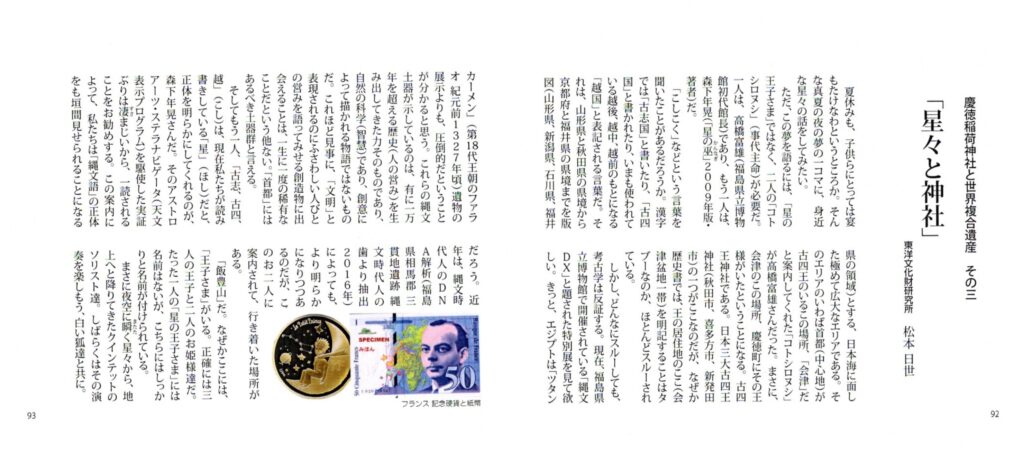Stars and Shrines

Keitoku Inari Shrine and World Heritage Site 3
Summer vacation is in full swing for children, isn’t it? I would like to talk about the stars around us in a scene from a midsummer night’s dream.
However, to tell this dream, we need not the “Little Prince”, but two “Kotoshiro-nushi” (Kotoshironushi no Mikoto). One is Takahashi Tomio (the first director of Fukushima Prefectural Museum), and the other is Morishita Toshiaki (author of the 2009 edition of “Kannagi of the Stars”).
Have you ever heard of the word “Koshikoku”? It is written in kanji as “Koshikuni” or “Koshikoku”, and is also written as “Echigo”, which is the basis of Echigo, Etchu, and Echizen that are still used today. It is an extremely vast area facing the Sea of Japan, with its territory stretching from the border between Yamagata and Akita prefectures to the border between Kyoto and Fukui prefectures (the territories of Yamagata, Niigata, Ishikawa, and Fukui prefectures). The “Kotoshiro-nushi” who guided me was Takahashi Tomio, who told me that the capital (center) of the area was Aizu, the place where the four kings lived. So it turns out that the king lived in this place in Aizu, Keitoku-cho. This is Koshio Shrine. This is one of the three major Koshio Shrines in Japan (Akita City, Kitakata City, Shibata City), but for some reason, it is almost always ignored in history books, perhaps because it is taboo to specify where the king lived (the Aizu Basin area). However, no matter how much it is ignored, archaeology refutes it. I would like you to see the special exhibition titled “Jomon DX” currently being held at the Fukushima Prefectural Museum. I’m sure you will find that Egypt is more overwhelming than the exhibit of “Tutankhamun” (the 18th dynasty pharaoh, around 1327 BC) relics. These Jomon pottery pieces show the power that has created over 10,000 years of history (human activities), the science of nature (wisdom), and not a story drawn by imagination. It is a rare, once-in-a-lifetime experience to encounter a creation that so beautifully tells the story of people’s activities that are worthy of being described as “civilization.” It is a group of pottery that should be found in the “capital.” And there is another person, Toshiaki Morishita, who reveals the true identity of “Koji, Koshi, Koshi” (Koshi), as the “star” (hoshi) that we read and write today. His demonstration using AstroArts StellaNavigator (astronomical display program) is amazing, so I recommend you read it. This guide will give us a glimpse into the true nature of the “Jomon language.” In recent years, more is being revealed through DNA analysis of Jomon people (extracted from Jomon human teeth at the Sankanji site in Soma County, Fukushima Prefecture in 2016), but these two guided me to a place: Mt. Iide. For some reason, there is a “prince” here. Three princes and two princesses to be exact. The lone “Little Prince” has no name, but these three do. It’s like a quintet of soloists descending to earth from the stars twinkling in the night sky. Let’s enjoy their performance for a while, together with the white foxes.
